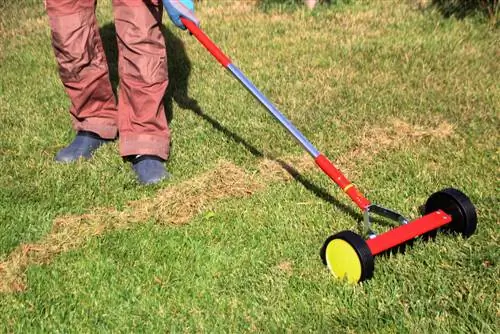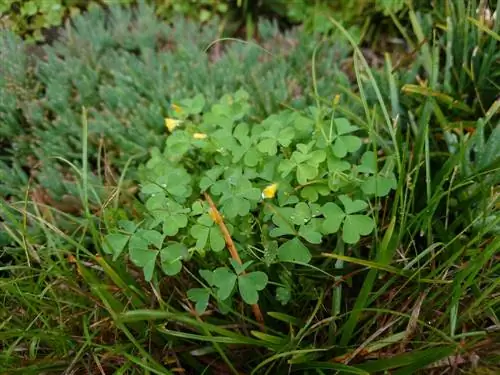- Author admin [email protected].
- Public 2023-12-16 16:46.
- Last modified 2025-01-23 11:20.
In some lawns, certain amounts of white clover are a welcome component, as they produce pretty flowers and fill in bare spots well. If there is heavy clover growth in the bed, it is usually the reddish horn sorrel (Oxalis corniculata), which can really become a pest.

How can you fight clover in the bed?
To effectively combat clover in the bed, we recommend early weeding, covering with ground film, bark mulch, changing the pH value and using ground cover. When purchasing plants, pay attention to clover introduced.
The properties of horn sorrel
The horn sorrel spreads in beds or in diseased lawns, especially if they have a slightly acidic soil substrate. In contrast to other types of clover, the above-ground parts of the plant sometimes die in periods of drought or in winter, but the plant is still hardy and can sprout new ones from the fleshy roots in the ground. If countermeasures are not taken in time, this plant can spread rapidly in a relatively open area and is then difficult to eliminate.
How horn sorrel spreads in the garden
The horn sorrel, like the clovers of the genus Trifolium, can spread in the garden through self-sowing and vegetative propagation. Since this clover can sometimes throw its seeds several meters through the air, it is sometimes colloquially referred to as “spring clover”. The seeds also have an appendage that is attractive to ants as a food source, so that they willingly carry the seeds throughout the garden on their migration routes. This means that the horn sorrel can quickly move from one bed to another and continue to multiply there.
Fight the horn sorrel as effectively as possible
Basically, horn sorrel should be prevented from spreading as early as possible if it is undesirable in the garden. Various procedures can be considered for this:
- chemical agents
- covering with a floor film
- regular weeding
- Cover empty spaces in the bed with bark mulch
- Change in soil pH
When weeding, the soil should first be loosened a little so that as many plants as possible can be removed along with the roots. Weeding the horn sorrel usually needs to be repeated several times until it shows clear results. Chemical agents only solve the problem temporarily; changing the pH value at the respective location is more helpful. If empty spaces in the bed are planted with other ground cover, they cannot be taken over by horn sorrel.
Tip
The horn sorrel is often introduced into your own garden in pots with purchased plants. Therefore, check purchased plants in the pot for this type of clover and remove existing clover plants including the roots before planting the purchased plants in the bed.






